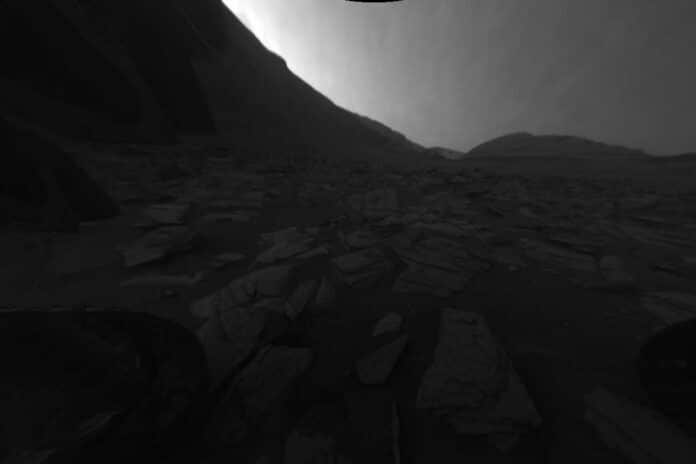On Nov. 8, the 4,002nd Martian day, or sol, of the mission, NASA’s Curiosity Mars rover captured two black-and-white videos showing a Martian day, from dawn to dusk. Using its black-and-white Hazard-Avoidance Cameras, or Hazcams, the rover captured its own shadow shifting across the surface of Mars.
Before Mars’s solar conjunction, when the Sun blocks radio communication, Curiosity received commands to record videos. Typically using Hazcams for navigation, the team utilized them to capture 12 hours of snapshots, aiming to observe clouds or dust devils and gain insights into Martian weather.
This initiative was unique as the rover’s activities were intentionally limited during the conjunction period. Despite reduced communication, regular health check-ins were maintained throughout the conjunction.
Despite not capturing noteworthy weather events, the videos transmitted from Curiosity after the conjunction reveal the passage of time on Mars. Covering the period from 5:30 a.m. to 5:30 p.m. local time, the videos show the rover’s silhouette shifting as the day progresses.
Using images from the front Hazcam, the first video looks southeast along Gediz Vallis, a valley on Mount Sharp, where Curiosity has been ascending since 2014.
During sunrise, as the Martian sky brightens, the rover’s robotic arm’s shadow shifts left, and Curiosity’s front wheels emerge from the darkness. The circular calibration target on the arm’s shoulder becomes visible, and engineers use it to test the accuracy of the Alpha Particle X-ray Spectrometer, which detects elements on Mars.
At midday, the front Hazcam’s exposure settles at about one-third of a second. By nightfall, it increases to over a minute, resulting in sensor noise known as “hot pixels,” appearing as white snow in the final image.
The second video shows the rear Hazcam’s view, looking northwest down Mount Sharp’s slopes to Gale Crater’s floor. The view includes Curiosity’s right rear wheel and the shadow of its power system. An artifact appearing midway through the video resulted from a cosmic ray, and the flashing at the end is caused by heat from the spacecraft’s power system affecting the Hazcam’s image sensor.
NASA/JPL-Caltech
The images have been re-projected to correct the wide-angle lenses, and the speckled appearance, particularly in the rear-camera video, is due to 11 years of Martian dust settling on the lenses.
